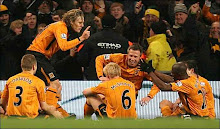
For the punters and armchair viewers, the best performer for Hull City this season has been Geovanni. While undoubtedly the most gifted player on the books, the assumption that he has been the top player in the team is slightly misguided.
Sure, when he is on song he is untouchable, and the rest of the midfield can enjoy an afternoon of giving him the ball and seeing what science-defying things he can do with it. However, the dip in team form since November has been epitomised by a downturn of his own.
The change in formation from the fabled 4-3-3 of September and October has changed Geovanni's role and impact on games. It was a necessary change, given the issues with impact and injury which had put the roles of a number of players - particularly Daniel Cousin, Dean Marney and George Boateng - under threat. The question mark against the 4-3-3, even when it was being used to win at Arsenal and scare Manchester United, was the lack of width, and eventually Phil Brown realised that the abundant wide players he had at his disposal needed to be utilised.
Geovanni, in the 4-3-3, was playing in a creative hole behind Cousin and Marlon King. He was semi-midfielder, semi-forward, if you like, and had Marney providing running space for him and Boateng protecting him and offering a route back if he got stuck in possession. The only time attacking width was used was when either Marney's considerable engine took him to a flank, or either of the full backs joined the fray having noted Ian Ashbee hanging back to provide cover for a counter attack.
Once the results of the team began to wane - losing to Chelsea was an acceptance of our limitations and to Manchester United covered in glory, but losing to Bolton Wanderers was a shock - then the answer to the riddle was to fill the midfield up and broaden it. This took Geovanni out of his showbiz role and put him wide left, allowing Bernard Mendy the chance to exploit his own mad brand of football on the other side. His role is still essentially free, but the extra discipline which applies to a wide role - being always available, off the ball running, tracking back - has rather nullified his effect.
Of course, even wildly talented Brazilians need to be team players and Geovanni has a better workrate than the stereotype of his type of performer would dictate. But he is really only useful - and that's very useful, of course - when he is possession of the ball and heading towards the opposition's byline or goal. A place in a wider area of the field means he is heading for the byline more and the net less, which more often than not rules out a chance for him to test a goalkeeper from distance.
His danger as a goalscorer is, of course, affected greatly by this. He was in a wide position when he received the ball at the Emirates, but was quickly allowed to come inside by a defence unfamiliar with him and lacking respect for the team, and he memorably punished them. Since going wider, he has not scored at all, and some of his shooting has been remarkably wayward for a player so dangerous.
Geovanni is now not set in stone as a first-team starter for the Tigers. He will, of course, be there more often than not, but as the team evolves and targets change, his brand of glittering showmanship will only be best served in a team which is on form and showing optimism. The arrival of Jimmy Bullard, a visionary player with a secondary ability to chase and graft, will also prompt further questions of Geovanni. His best hope for reclaiming the role of inspirer of men will be realised if City resume the 4-3-3 formation and restore him to that glamorous central position behind Cousin and another striker, with Bullard enjoying a deeper, surveying role behind him. However, if Brown sees Bullard as someone who poses a direct threat to Geovanni, the Brazilian may need to rethink his game.



.jpg)






